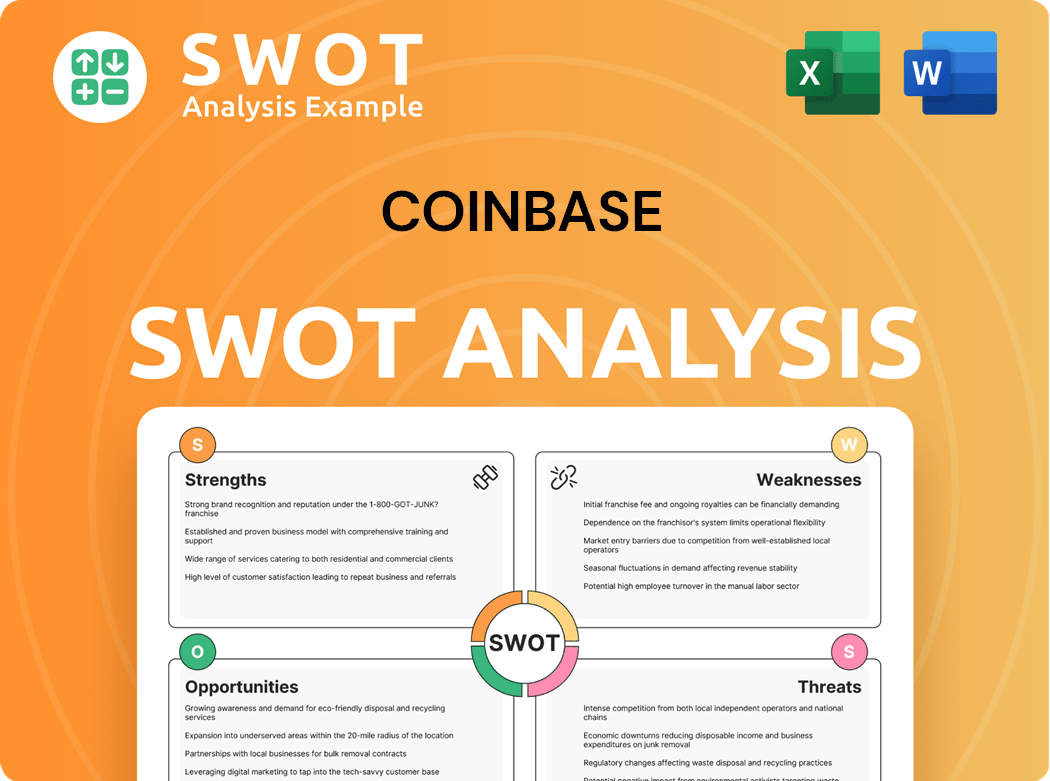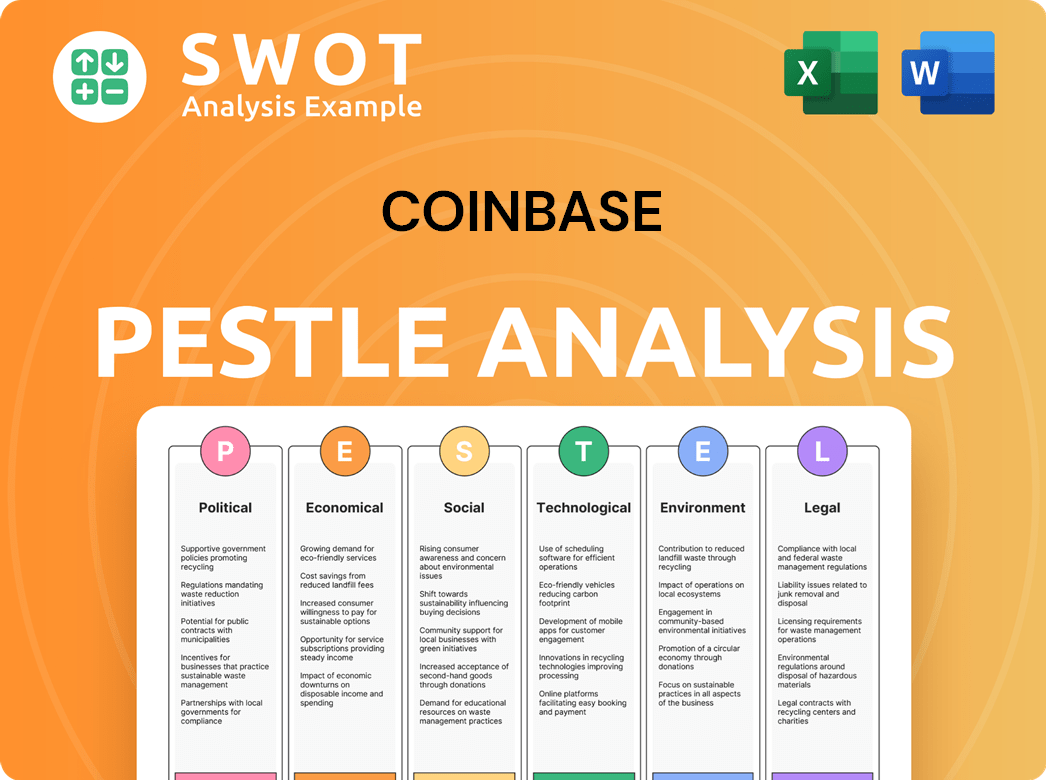Coinbase Bundle
How Does Coinbase Thrive in the Crypto World?
Coinbase, a leading Coinbase SWOT Analysis, has become a cornerstone of the Coinbase platform. The company's financial success, with revenue surging to $6.6 billion in 2024, reflects its strong position in the volatile Cryptocurrency market. With over 108 million customers, understanding how Coinbase operates is vital for anyone interested in Digital assets and the future of finance.

From Bitcoin to Ethereum, Coinbase offers a simple way to buy, sell, and store various cryptocurrencies. Its diverse services, including custody and staking, cater to both novice and experienced users. As the regulatory landscape for Coinbase exchange continues to evolve, its ability to adapt and innovate will be key to maintaining its leadership in the industry.
What Are the Key Operations Driving Coinbase’s Success?
Coinbase offers a comprehensive platform for engaging with the cryptoeconomy, making it easy to buy, sell, and store a wide variety of cryptocurrencies. The core offerings include the Coinbase Spot Market, Coinbase Prime, and the Coinbase app. This approach caters to both individual consumers and institutional clients, emphasizing trust and ease of use to make crypto transactions accessible for everyone.
The Coinbase platform focuses on providing secure and compliant services. This includes institutional-grade custody solutions and access to multiple trading venues. These venues, such as the Coinbase exchange, Coinbase International Exchange, and Coinbase Derivatives Exchange, support spot and derivatives trading. The company's commitment to compliance is a key differentiator in the complex regulatory environment.
Coinbase creates value by simplifying access to cryptocurrency. It offers a user-friendly experience that appeals to both beginners and experienced traders. The company's focus on security and regulatory compliance builds trust, which is essential in the digital assets market. This approach is designed to foster wider crypto adoption and utility.
The Coinbase Spot Market is the primary venue for buying and selling cryptocurrencies. It offers a straightforward interface for retail users to trade various digital assets. This market is designed for ease of use, making it accessible for new users.
Coinbase Prime provides institutional clients with a comprehensive suite of services. These services include advanced trading tools, custody solutions, and prime brokerage services. It caters to the sophisticated needs of institutional investors.
The Coinbase app is the primary interface for retail users to access the Coinbase platform. It allows users to buy, sell, and manage their Bitcoin and other digital assets. The app is designed for simplicity and ease of use.
Coinbase offers tailored solutions for institutional clients, including custody services. As of 2024, Coinbase serves as the custodian for 9 out of 11 spot Bitcoin ETFs and 8 out of 9 Ethereum ETFs. This highlights its trusted position in the institutional space.
Coinbase's operations involve continuous technological development, robust security measures, and extensive customer support. The company invests heavily in employee learning and development, including an annual learning stipend and in-house crypto learning curriculum. This ensures a knowledgeable workforce capable of navigating the evolving crypto landscape.
- Technology Development: Continuous improvement of the Coinbase platform.
- Security Measures: Robust security protocols to protect user assets.
- Customer Support: Comprehensive support to assist users with their needs.
- Global Presence: Expanding its market infrastructure and global presence.
In Q4 2024, the Base network, an L2 Ethereum blockchain, generated over 8,047 ETH ($26.36 million) in total revenue. For further insights, you can explore the Competitors Landscape of Coinbase.
Coinbase SWOT Analysis
- Complete SWOT Breakdown
- Fully Customizable
- Editable in Excel & Word
- Professional Formatting
- Investor-Ready Format

How Does Coinbase Make Money?
Coinbase, a leading Coinbase platform for buying, selling, and storing cryptocurrency, employs a multifaceted approach to generate revenue. Its financial success hinges on a combination of transaction fees from trading activities and subscription services. The company's ability to adapt to market fluctuations and expand its service offerings is critical to its financial performance.
The Coinbase exchange has two primary revenue streams: transaction fees and subscription services. These streams have been instrumental in the company's financial performance, particularly in recent years. Understanding how these components contribute to overall revenue provides insight into the financial health and operational strategies of the company.
In 2024, Coinbase's total revenue reached $6.6 billion, a testament to the company's robust business model. This growth was driven by significant contributions from both transaction fees and subscription services. The company's financial performance is closely tied to the dynamic nature of the digital assets market.
Transaction revenue is a major source of income for Coinbase, generated from trading activities by both consumers and institutions. This segment is heavily influenced by the trading volume of crypto assets like Bitcoin and Ethereum. Market volatility significantly impacts this revenue stream.
In 2024, transaction revenue saw a substantial increase of 162%, reaching approximately $4 billion. Consumer trading contributed more to this revenue than institutional trading. This surge reflects increased trading activity and the overall growth of the crypto market.
Subscription and services revenue includes various offerings such as stablecoin revenue, blockchain rewards, and custodial fees. This segment also experienced considerable growth, reflecting the diversification of Coinbase's revenue streams and the expansion of its service offerings.
Subscription and services revenue grew by 64% in 2024, reaching $2.3 billion. This growth was fueled by increased participation in the crypto ecosystem and the integration of services like USDC stablecoin. This segment's expansion highlights the company's strategic diversification efforts.
Coinbase earns revenue from USDC primarily through interest income on reserves via a revenue-sharing agreement with Circle. USDC balances on Coinbase surged nearly 50% to $12.3 billion as of December 31, 2024, highlighting the importance of stablecoins in the company's revenue model.
Coinbase One, a subscription service, offers benefits such as zero trading fees, account takeover protection, and boosted USDC rewards. This service saw continued subscriber growth in 2024 and Q1 2025, contributing to the company's recurring revenue streams. The subscription model helps stabilize income.
In Q1 2025, total revenue was $2.03 billion, with transaction revenue at $1.3 billion and subscription and services revenue at $698 million. The company is actively exploring new revenue streams, such as tokenized securities and predictive markets, to diversify its offerings and maintain growth. To learn more about the company's strategic moves, read about the Growth Strategy of Coinbase.
- Coinbase's revenue model is primarily built on transaction fees and subscription services.
- Transaction revenue is heavily influenced by crypto asset trading and market volatility.
- Subscription and services revenue includes stablecoin revenue, blockchain rewards, and custodial fees.
- The company is exploring new revenue streams to diversify its offerings.
Coinbase PESTLE Analysis
- Covers All 6 PESTLE Categories
- No Research Needed – Save Hours of Work
- Built by Experts, Trusted by Consultants
- Instant Download, Ready to Use
- 100% Editable, Fully Customizable

Which Strategic Decisions Have Shaped Coinbase’s Business Model?
Coinbase has achieved several significant milestones, shaping its operations and financial performance. The launch of Bitcoin exchange-traded fund (ETF) products in early 2024 and a more 'pro-crypto' political environment contributed to increased trading volume and higher crypto asset prices, significantly boosting Coinbase's transaction revenue. The company expanded its market infrastructure in 2024 by providing access to three trading venues: the Coinbase Exchange, the Coinbase International Exchange, and the Coinbase Derivatives Exchange, supporting both spot and derivatives trading.
In 2024, Coinbase launched new products like the 'smart wallet' feature for Coinbase Wallet and the Base Protocol, an L2 Ethereum blockchain, aimed at reducing transaction fees and increasing on-chain activity. In Q1 2025, Coinbase enhanced its Coinbase One subscription service with new benefits such as free gas fees on Base and boosted staking rewards. The company also introduced a feature allowing users to borrow USDC against their Bitcoin holdings, facilitating over $160 million in loans since its inception. A major strategic move in Q1 2025 was the announced $2.9 billion acquisition of Deribit, a leading global crypto derivatives exchange.
Operational challenges faced by Coinbase include the highly volatile nature of the cryptoeconomy, which causes substantial fluctuations in operating results, and a complex, rapidly evolving regulatory environment. To address these, Coinbase dynamically adjusts its expense base in response to market conditions and revenue opportunities. The company also initiated a 'Delete Week' in January 2024 to streamline operations and enhance agility. Coinbase's competitive advantages include its user-friendly interface, strong security measures, and a focus on regulatory compliance, which sets it apart from competitors like Binance, Kraken, and Gemini. Its position as a publicly listed company and its role as a custodian for numerous Bitcoin and Ethereum ETFs further bolster trust in its platform. Coinbase continues to adapt to new trends by expanding its product offerings, deepening institutional adoption, and driving international growth, with a focus on regulatory clarity.
Coinbase's key milestones include the launch of Bitcoin ETF products and expansion of its market infrastructure. These strategic moves have significantly impacted its trading volumes and revenue streams. The introduction of new products like 'smart wallet' and Base Protocol further enhanced user experience and on-chain activity.
Strategic moves include the acquisition of Deribit for $2.9 billion and the enhancement of Coinbase One subscription. The company also introduced features like borrowing USDC against Bitcoin holdings. These moves are aimed at expanding services and increasing user engagement within the Coinbase platform.
Coinbase's competitive advantages include its user-friendly interface and strong security. Its focus on regulatory compliance and its role as a custodian for ETFs further build trust. Coinbase continues to adapt by expanding product offerings and focusing on international growth.
Coinbase faces challenges due to the volatile nature of the crypto market and complex regulations. To address these, the company adjusts its expenses dynamically and streamlines operations. The 'Delete Week' initiative in January 2024 is an example of its agility.
Coinbase's strategic initiatives, such as the acquisition of Deribit and enhancements to its subscription services, are designed to broaden its service offerings and strengthen its market position. These moves are part of a broader strategy to attract both retail and institutional investors. The company is also focused on expanding its global footprint and ensuring regulatory compliance.
- Coinbase is a publicly listed company, which enhances trust and transparency.
- The company's focus on regulatory compliance sets it apart from many competitors.
- Coinbase's user-friendly interface and robust security measures are key advantages.
- The introduction of features like borrowing USDC against Bitcoin aims to increase user engagement.
Coinbase Business Model Canvas
- Complete 9-Block Business Model Canvas
- Effortlessly Communicate Your Business Strategy
- Investor-Ready BMC Format
- 100% Editable and Customizable
- Clear and Structured Layout

How Is Coinbase Positioning Itself for Continued Success?
The company holds a leading position in the cryptocurrency exchange market, especially in the U.S. It operates the largest U.S.-based cryptocurrency exchange, boasting over 108 million customers. With a dominant 66% market share in the United States and managing over $400 billion in assets, the company emphasizes trust and ease of use to support customer loyalty. The company is also actively pursuing global expansion, recognizing that approximately 80% of the global crypto trading market occurs outside the U.S.
However, the company faces risks primarily due to the volatile nature of the cryptoeconomy, which directly impacts its transaction fee-dependent revenue. Regulatory changes are another significant challenge. The ongoing SEC lawsuit regarding the classification of certain crypto assets as securities highlights this, although a dismissal of the SEC lawsuit in Q1 2025 was a major judicial win for balanced regulation. Competition from other exchanges offering lower fees and more advanced trading features also presents a challenge. To learn more about its customer base, check out the target market of the company.
The company is the leading cryptocurrency exchange in the U.S., with a significant market share. Its focus on trust and ease of use has helped build customer loyalty. The company is expanding globally to tap into markets outside the U.S.
The volatile nature of the cryptocurrency market poses a risk to its revenue. Regulatory changes and legal challenges also present threats. Competition from other exchanges with lower fees is another factor.
The company is focused on revenue growth and regulatory clarity. Strategic initiatives include institutional adoption and global expansion. The company anticipates significant growth in tokenization and DeFi in 2025.
Deepening institutional adoption. Scaling international growth. Expanding real-world utility of crypto. Investing in core products like derivatives and Coinbase One. Adapting to market and regulatory changes.
The company anticipates 2025 as a pivotal year for U.S. crypto legislation, with a shift towards pro-crypto regulation. The company expects the tokenization of real-world assets and the resurgence of DeFi to be key themes in 2025. The company aims to sustain its growth by focusing on these strategic areas and maintaining a strong balance sheet.
- The company expects tokenization market expansion.
- Focus on maintaining a strong balance sheet with over $9.9 billion in total USD resources as of Q1 2025.
- Anticipates pro-crypto regulation in the U.S. in 2025.
- Continued investment in core products.
Coinbase Porter's Five Forces Analysis
- Covers All 5 Competitive Forces in Detail
- Structured for Consultants, Students, and Founders
- 100% Editable in Microsoft Word & Excel
- Instant Digital Download – Use Immediately
- Compatible with Mac & PC – Fully Unlocked

Related Blogs
- What are Mission Vision & Core Values of Coinbase Company?
- What is Competitive Landscape of Coinbase Company?
- What is Growth Strategy and Future Prospects of Coinbase Company?
- What is Sales and Marketing Strategy of Coinbase Company?
- What is Brief History of Coinbase Company?
- Who Owns Coinbase Company?
- What is Customer Demographics and Target Market of Coinbase Company?
Disclaimer
All information, articles, and product details provided on this website are for general informational and educational purposes only. We do not claim any ownership over, nor do we intend to infringe upon, any trademarks, copyrights, logos, brand names, or other intellectual property mentioned or depicted on this site. Such intellectual property remains the property of its respective owners, and any references here are made solely for identification or informational purposes, without implying any affiliation, endorsement, or partnership.
We make no representations or warranties, express or implied, regarding the accuracy, completeness, or suitability of any content or products presented. Nothing on this website should be construed as legal, tax, investment, financial, medical, or other professional advice. In addition, no part of this site—including articles or product references—constitutes a solicitation, recommendation, endorsement, advertisement, or offer to buy or sell any securities, franchises, or other financial instruments, particularly in jurisdictions where such activity would be unlawful.
All content is of a general nature and may not address the specific circumstances of any individual or entity. It is not a substitute for professional advice or services. Any actions you take based on the information provided here are strictly at your own risk. You accept full responsibility for any decisions or outcomes arising from your use of this website and agree to release us from any liability in connection with your use of, or reliance upon, the content or products found herein.